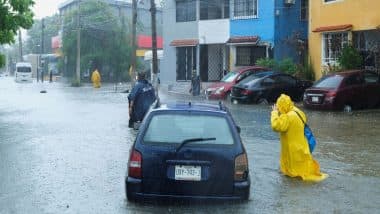Crawfordville, September 27: Hurricane Helene weakened to a Category 1 hurricane early Friday with maximum sustained winds of 75 mph (120 kph), according to the National Hurricane Center. The storm travelled north from Florida to Georgia and was about 100 miles (160 kilometres) from Augusta and 40 miles (65 kilometres) from Macon moving at about 30 mph (48 kph), the hurricane center in Miami said in a 4 am update.
The storm made landfall in northwestern Florida as a Category 4 storm as forecasters warned the enormous system could create a “nightmare” storm surge and bring dangerous winds and rain across much of the southeastern US. There were at least three storm-related deaths. The hurricane centre said Helene roared ashore around 11:10 pm Thursday near the mouth of the Aucilla River in the Big Bend area of Florida's Gulf Coast. It had maximum sustained winds estimated at 140 mph (225 kph). That location was only about 20 miles (32 kilometres) northwest of where Hurricane Idalia came ashore last year at nearly the same ferocity and caused widespread damage. Hurricane Helene Update: Helene Upgraded to Category 4 Storm As Power Outages and Flooding Hit Florida Ahead of Landfall.
Helene prompted hurricane and flash flood warnings extending far beyond the coast up into northern Georgia and western North Carolina. More than 1.2 million homes and businesses were without power in Florida, more than 190,000 in Georgia and more than 30,000 in the Carolinas, according to the tracking site poweroutage.us. The governors of those states and Alabama and Virginia all declared emergencies.
One person was killed in Florida when a sign fell on their car and two people were reported killed in a possible tornado in south Georgia as the storm approached. “When Floridians wake up tomorrow morning, we're going to be waking up to a state where very likely there's been additional loss of life and certainly there's going to be loss of property," Florida Gov. Ron DeSantis said at a news conference Thursday night.
Helene was moving rapidly inland after making landfall, with the centre of the storm set to race from southern to northern Georgia through early Friday morning. The risk of tornadoes also would continue overnight and into the morning across north and central Florida, Georgia, South Carolina and southern North Carolina, forecasters said. Later Friday, there would be the risk of tornadoes in Virginia. Viral Video Captures Massive Flooding Outside Tampa General Hospital as Hurricane Helene Continues, Aquafence Installation Keeps Hospital Protected.
“Helene continues to produce catastrophic winds that are now pushing into southern Georgia,” the hurricane centre said in an update at 1 am Friday. “Persons should not leave their shelters and remain in place through the passage of these life-threatening conditions.” The hurricane's eye passed near Valdosta, Georgia, as the storm churned rapidly north into Georgia Thursday night. The National Hurricane Center issued an extreme wind warning for the area, meaning possible hurricane-force winds exceeding 115 mph (185 kph).
Helene is the third storm to strike the city in just over a year. Tropical Storm Debby blacked out power to thousands in August, while Hurricane Idalia damaged an estimated 1,000 homes in Valdosta and surrounding Lowndes County a year ago. Even before landfall, the storm's wrath was felt widely, with sustained tropical storm-force winds and hurricane-force gusts along Florida's west coast. Water lapped over a road in Siesta Key near Sarasota and covered some intersections in St. Pete Beach. Lumber and other debris from a fire in Cedar Key a week ago crashed ashore in the rising water.
Beyond Florida, up to 10 inches (25 centimetres) of rain had fallen in the North Carolina mountains, with up to 14 inches (36 centimetres) more possible before the deluge ends, setting the stage for flooding that forecasters warned could be worse than anything seen in the past century. Heavy rains began falling and winds were picking up earlier Thursday in Valdosta, Georgia, near the Florida state line. The weather service said more than a dozen Georgia counties could see hurricane-force winds exceeding 110 mph (177 kph).
In south Georgia, two people were killed when a possible tornado struck a mobile home on Thursday night, Wheeler County Sheriff Randy Rigdon told WMAZ-TV. Wheeler County is about 70 miles (113 kilometres) southeast of Macon. The storm made landfall in the sparsely-populated Big Bend area, home to fishing villages and vacation hideaways where Florida's Panhandle and peninsula meet.
“Please write your name, birthday, and important information on your arm or leg in a PERMANENT MARKER so that you can be identified and family notified,” the sheriff's office in mostly rural Taylor County warned those who chose not to evacuate in a Facebook post, the dire advice similar to what other officials have dolled out during past hurricanes. Still, Philip Tooke, a commercial fisherman who took over the business his father founded near the region's Apalachee Bay, planned to ride out this storm like he did during Hurricane Michael and the others: on his boat. “If I lose that, I don't have anything,” Tooke said.
Michael, a Category 5 storm, all but destroyed one town, fractured thousands of homes and businesses and caused some $25 billion in damage when it struck the Florida Panhandle in 2018. Many, though, were heeding the mandatory evacuation orders that stretched from the Panhandle south along the Gulf Coast in low-lying areas around Tallahassee, Gainesville, Cedar Key, Lake City, Tampa and Sarasota.
Federal authorities staged search-and-rescue teams as the weather service forecast storm surges of up to 20 feet (6 metres) and warned they could be particularly “catastrophic and unsurvivable” in Apalachee Bay. “Please, please, please take any evacuation orders seriously!” the office said, describing the surge scenario as “a nightmare.” School districts and multiple universities cancelled classes. Airports in Tampa, Tallahassee and Clearwater were closed Thursday, while cancellations were widespread elsewhere in Florida and beyond.
While Helene will likely weaken as it moves inland, damaging winds and heavy rain were expected to extend to the southern Appalachian Mountains, where landslides were possible, forecasters said. Tennessee was among the states expected to get drenched. Helene had swamped parts of Mexico's Yucatan Peninsula on Wednesday, flooding streets and toppling trees as it passed offshore and brushed the resort city of Cancun. In western Cuba, Helene knocked out power to more than 200,000 homes and businesses as it brushed past the island.
Areas 100 miles (160 kilometres) north of the Georgia-Florida line expected hurricane conditions. The state opened its parks to evacuees and their pets, including horses. Overnight curfews were imposed in many cities and counties in south Georgia. For Atlanta, Helene could be the worst strike on a major Southern inland city in 35 years, said University of Georgia meteorology professor Marshall Shepherd. Helene is the eighth named storm of the Atlantic hurricane season, which began June 1. The National Oceanic and Atmospheric Administration has predicted an above-average Atlantic hurricane season this year because of record-warm ocean temperatures.












 Quickly
Quickly





















